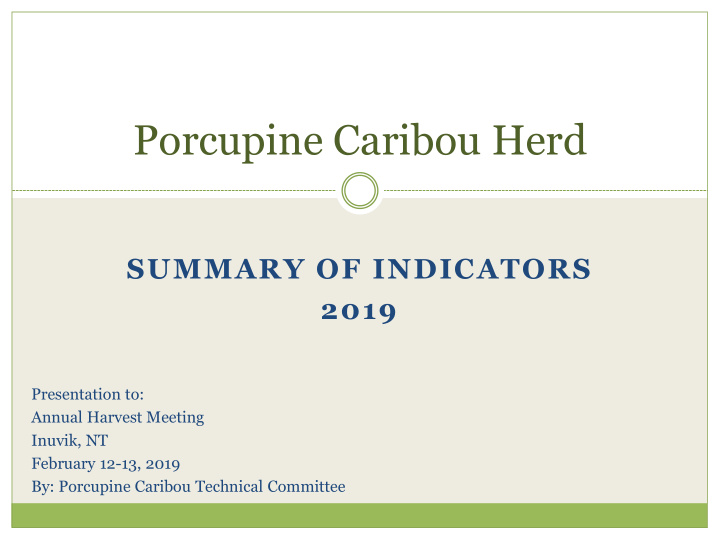



Porcupine Caribou Herd SUMMARY OF INDICATORS 2019 Presentation to: Annual Harvest Meeting Inuvik, NT February 12-13, 2019 By: Porcupine Caribou Technical Committee
Range of Porcupine Caribou Herd
Population Harvest Body Condition Habitat Alaska Department of Fish and Game Overview
Population Size Methods Results Count caribou using a photocensus Last completed in 2017 July 1 st , 2017 Alaska July 4 th , 2017 Yukon Photo-direct technique and digital photography Population estimates scheduled every 2-3 years (2019)
Population Size
Population Size Methods Results 250000 218,457 caribou 218,000 caribou 225000 in 2017 (202,106 - 234,808) 200000 Population Size 175000 Minimum count = 150000 197,894 caribou 125000 Increasing ( λ =1.35) 100000 75000 similar to growth rate 50000 between 1972-1989. 25000 0 1970 1975 1980 1985 1990 1995 2000 2005 2010 2015 Upper CI Lower CI
Calf Birth Rate and Survival Methods Results Classify pregnancy on calving grounds (2018) 88% of females pregnant Long term average of 82% Check to see how many calves survive after 1 month 88% of those calves survived Long term average is 86% After 1 month: 64 calves per 100 cows
Adult Female Survival Methods Results Annual Survival of Adult Female Porcupine Caribou Percentage of females (Error bars are 95% confidence limits that survive each year Last completed in 2017 Female Annual Survival 95.4% of adult females survived (83.9%-98.2%) Survival is estimated using GPS collar data From 2012-2017, survival ranged from 79.6%-94.5% Caribou Year (calving to calving period)
Population Roll Up Herd at the highest recorded population size High adult female survival Calf-cow ratio higher than average Pregnancy rate higher than average Calf survival average Alaska Department of Fish and Game
Population Harvest Body Condition Habitat Peter Mather Overview
Harvest Monitoring Methods Interview based sampling survey of user groups 1. Harvest estimates, sex ratio of harvest Review these later today
Population Harvest Body Condition Habitat Overview
Caribou Body Condition Methods Results How healthy individual Generally – very good caribou are by shape for time of year measuring back fat and Average score of 3.2/4 rating animals which is above the five Fall and winter 2017- year average (2.9/4) 2018 hunter samples submitted (Old Crow and NWT) 15 bulls sampled for back fat
Caribou Body Condition Average condition of harvested caribou 1=poor, 2=fair 3=good 4=very good
Caribou Body Condition Average Depth of Backfat (cm)
Population Harvest Body Condition Habitat Overview
Wildland Fires Methods Results Amount of PCH range burned as an index of range condition 1960 — 2017 Fires in red are new as of 2017 2018 data not yet available however no significant fires noted
In 2016 there were 9 fires in Alaska, and no fires within the YT and NWT portion of the PCH range In 2017, 53 fires burned in AK and YT Wildland fires in PCH Range
A fraction of the area burned in the previous 5 years Total area burned is roughly 17% of herd’s total annual range since 1960 2017 saw an additional 2% of Wildland fires in PCH the range burn that had not been Range burned since 1960
Human Disturbance and Footprint Methods Measured total linear footprint for each disturbance type No appreciable change in linear footprint in 2017/2018 Oil and gas lease sales and winter seismic testing proposed for 1002 lands in Alaska
Snow Conditions Methods Index of winter conditions Measurements of depth and snow density measured at 17 permanent locations 1977-2018 Alaska Department of Fish and Game
No trends or large changes from long term averages Old Crow and Ogilvie = average snow depth and density Eagle River drainage = increasing trend towards a deep snowpack over the last decade Snow Conditions
Winter distribution in Alaska between Arctic Village and the Dalton Highway Snow depth and density was above average in the Eagle Region, but near average in the Ogilvie and Old Crow regions Snow Conditions
Habitat Roll Up Habitat did not change much over the year Snow conditions average in most places except for the Eagle Region Alaska Department of Fish and Game
Questions? Peter Mather
Indicator Table - Nov. 2018
Indicator Table - Nov. 2018
Indicator Table - Nov. 2018
Recommend
More recommend